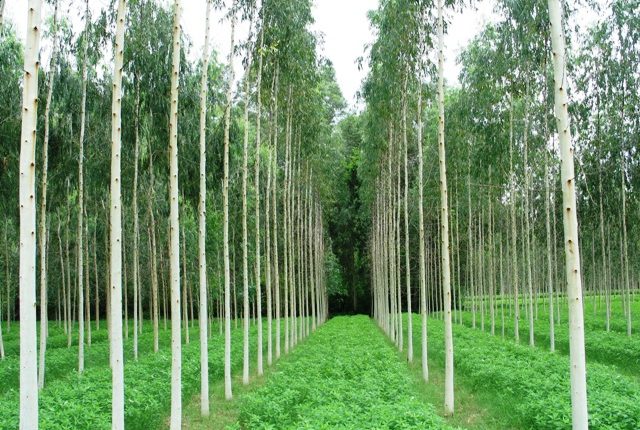The Times of India, Bengaluru reports on this radical and much-needed move by the Congress-led Siddharamaiah government.

It was the World Bank-aided project to supply firewood and timber to feed the rapidly unfolding urbanisation back in the 1980s that ended up converting the districts of Bengaluru Rural, Kolar and Chikkaballapur into barren lands today.Largescale planting of eucalyptus and acacia trees under the Social Forestry scheme to meet the firewood and timber demand not only squeezed the districts of its rich underground water table, but also made annual rainfall in the region a mirage of its former self. Even though the state government had directed the Karnataka Forest Department (KFD) not to create Eucalyptus plantations back in 2011 saying it would have a serious impact on the ground water levels, there was no proper documentation on the damage caused to the ecosystem. However, with pressure being mounted on the government to extend the ban on farmers and the general public from planting these species, the KFD has notified shocking revelations on how these species made these three major districts barren.
Finally, heeding cries of environmental activists, the state government has banned creation of eucalyptus and acacia groves in Karnataka since February 2017.Putting together various research papers, studies and observations by forest officials, agriculture and geology researchers belonging to various organisations, an expert committee headed by the Minister for Forests, Ecology and Environment studied the subject in detail in January 2017 and were shocked to learn that eucalyptus and acacia were responsible for the present day parched condition of these districts.
Species exhausted entire water table in two decades
A senior official from the KFD told Bangalore Mirror that a first-ever collaborative study on these species was taken up in the late 1990s by KFD, Institute of Hydrology (UK) and Mysore Paper Mills. "They chose three locations in Shivamogga and Bengaluru Rural (Hoskote) which had recorded an average rainfall of 800 mm every year. After the third and fourth sightings, it was discovered that the usage of water by these species was higher than agriculture crops. Especially in Hoskote, Bengaluru Rural district, the amount of water drawn by these eucalyptus plantations for a period of three years was greater than the actual rainfall," Forest Minister B Ramanatha Rai revealed.
Until then, the water table in these districts was anywhere between 100 and 200 mt. "Yet another study by Mukund Joshi and K Palanisami on the ground water condition of Kolar area revealed that 20 years of continuous cultivation of eucalyptus in private and public lands deepened the freshly-dug borewells up to 260 mt from the mean depth of 177 mt. The findings were so alarming that even National Green Tribunal (NGT) referred to the findings while hearing a case pertaining to Punjab and made remarkable observations on effect of eucalyptus on ground water scenario in 2014," a senior KFD official, who was part of the committee, told BM.
According to NGT observations, even though the distance from the eucalyptus plantation had a negative correlation with the depth of freshly dug borewells, the borewell yield was reduced by 35 to 42 per cent in less than 3 to 5 years. All of them were well within the diametre of 1 km from a eucalyptus plantation. Observations are backed by factors such as identical set of soil, rainfall, rock formation and cropping.
"The NGT pronounced in its order that eucalyptus is well-known for high water uptake ranging from 50 ltr a day to 90 ltr a day depending on the adequacy of supply. In stressful conditions such as drought, its roots are capable of reaching out up to 20-30 feet and extracting more water. Species such as eucalyptus are regarded as bio-drainage species to poorly-drained areas," the official quoted from the NGT order.
Eucalyptus—The villain
On the plummeting levels of the underground water table in various parts of the state, especially in these districts, the government was told that an increase in number of borwells is the major reason for the fall. But now the government has also realised that the last nail in the coffin was delivered by these eucalyptus plantations.
"The water table in most of the districts is dipping further as the years go on quite rapidly. In terms of the status of ground water exploitation, many taluks in the state are over-exploited or in a semi-critical stage. But eucalyptus plantations are quite common in many districts. Further, these districts are not the areas the NGT has found favourable for planting eucalyptus in its order. In view of the research findings and NGT order, there is sufficient reason to believe that high intensity and number of eucalyptus plantations is one of the many causes for the falling levels of water table and requires to be checked," Rai said
The government also discovered that propagating the tree species causes colonisation of an alien or invasive species which is the host or alternate host for pests and vectors that can cause diseases adversely affecting the hygiene.
CHRONOLOGY OF A EUCALIPTO
* Eucalyptus was introduced for planting under World Bank aided Social Forestry project in 1980s for firewood and small timber
* In1984, the govt banned cultivation of eucalyptus in areas with more than 750 mm rainfall as it had begun to be infected by a fungus
* In the late 1990s, the government removed eucalyptus from the list of species to be planted under the rural development schemes under a GoI initiative
* In 1990, the government restricted the planting of eucalyptus to areas that receive rainfall between 500 mm and 750 mm annually
* In 2011, a circular banning the raising of eucalyptus at KFD nurseries was issued
* In 2017, an official ban on cultivation and propagation of eucalyptus trees by anybody across Karnataka was put in place by amending the Karnataka Tree Preservation Act